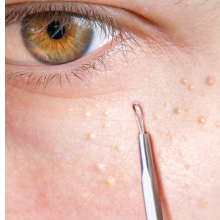Milia are small, white cysts that typically appear on the face, particularly around the eyes, cheeks, and nose. While they are harmless and often painless, they can affect your skin’s appearance and lead to a feeling of self-consciousness. If you're struggling with milia, it's essential to know that various Milia Treatments in Dubai can help restore your skin's glow. In this article, we will explore effective milia treatments, their benefits, and how to maintain a clear complexion.
Understanding Milia
Milia are formed when keratin, a protein found in skin cells, becomes trapped beneath the surface of the skin. They can occur at any age and are often mistaken for whiteheads. Unlike acne, which can be inflamed and red, milia are small, firm, and do not usually cause any discomfort. They may appear in clusters and can last for weeks or even months. Knowing the causes and types of milia can help you understand the best course of treatment.
Causes of Milia
Milia can develop due to various reasons, including:
- Skin Damage: Conditions like sunburn, blistering, or prolonged irritation can lead to milia formation.
- Genetics: Some individuals are more prone to developing milia due to their genetic makeup.
- Use of Heavy Skin Products: Certain creams and cosmetics that clog pores can contribute to milia development.
- Age: As we age, our skin's ability to regenerate slows down, increasing the likelihood of milia.
Effective Milia Treatments
While milia often resolve on their own, several treatment options can speed up the process and restore your skin's radiance. Here are some effective milia treatments:
1. Topical Retinoids
Topical retinoids, derived from vitamin A, are a common treatment for milia. They promote skin cell turnover, helping to prevent the formation of new milia while encouraging the shedding of trapped cells. Regular use can lead to smoother skin and a reduction in the appearance of existing milia. However, retinoids can be irritating, so it’s essential to introduce them gradually into your skincare routine.
2. Exfoliation
Regular exfoliation can help remove dead skin cells and prevent the buildup that leads to milia. Consider using gentle exfoliating scrubs or chemical exfoliants containing alpha hydroxy acids (AHAs) or beta hydroxy acids (BHAs). These ingredients work by dissolving the bonds between dead skin cells, promoting a brighter and smoother complexion.
3. Professional Extraction
If milia persist or are particularly bothersome, professional extraction by a dermatologist or licensed aesthetician can be an effective solution. Using a sterile needle or small blade, the professional will carefully remove the cysts without damaging the surrounding skin. This treatment can provide immediate results and is often combined with other treatments for optimal outcomes.
4. Cryotherapy
Cryotherapy involves the application of extreme cold to the skin, effectively freezing the milia. This treatment causes the cysts to fall off after a short period. It’s a quick procedure that is generally well-tolerated, making it an appealing option for those looking for rapid results.
5. Laser Treatments
Laser treatments can target milia effectively by focusing on the cysts without damaging the surrounding skin. Various laser types can be used, such as fractional lasers, which promote collagen production and skin renewal. These treatments can improve the overall texture and tone of the skin while eliminating milia.
Aftercare Tips
After receiving treatment for milia, it’s essential to follow a proper skincare routine to maintain your skin's health and prevent new milia from forming. Here are some tips:
1. Gentle Cleansing
Use a gentle cleanser that won’t strip your skin of its natural oils. Avoid harsh scrubs and soaps that can irritate the skin.
2. Moisturize Regularly
Hydrating your skin is vital to its recovery and overall health. Choose a lightweight, non-comedogenic moisturizer to keep your skin hydrated without clogging pores.
3. Sunscreen Protection
Sun protection is crucial after any skin treatment. Use a broad-spectrum sunscreen with an SPF of at least 30 to shield your skin from harmful UV rays and prevent further damage.
4. Avoid Heavy Makeup
While your skin is healing, consider reducing the use of heavy makeup. Allow your skin to breathe and recover from any treatments you may have undergone.
5. Consult a Dermatologist
If you notice that milia persist despite your efforts, it’s wise to consult a dermatologist. They can recommend tailored treatments based on your skin type and concerns.
Preventing Milia
Prevention is always better than cure. To reduce the risk of developing milia, consider these preventive measures:
- Choose Non-Comedogenic Products: Opt for skincare and makeup products that are labeled as non-comedogenic, which means they are less likely to clog pores.
- Stay Hydrated: Drinking enough water helps keep your skin hydrated and promotes overall health.
- Maintain a Consistent Skincare Routine: Regular cleansing, exfoliating, and moisturizing can help keep your skin clear and radiant.
- Be Mindful of Sun Exposure: Protect your skin from excessive sun exposure, which can damage the skin and lead to milia.
Conclusion
Milia are common skin concerns that can affect anyone, but they are manageable with the right treatments and preventive measures. By exploring effective milia treatments and incorporating them into your skincare routine, you can restore your skin’s glow and boost your confidence. Always consult with a skincare professional to determine the best approach for your unique skin type and concerns. Remember, a healthy skincare regimen is essential for preventing the recurrence of milia and maintaining beautiful, radiant skin.





Comments